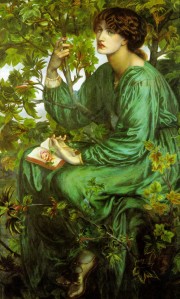‘All Rossetti’s failing concentration and genius was lavished upon this beautiful canvas.’[1] – Evelyn Waugh
The Day Dream (1880) 158.7 x 92.7cm is an oil on canvas painting by Dante Gabriel Rossetti (1828-1882). Known as ‘Rossetti’s last worthy painting’[2], it was displayed in the Royal Academy in 1883 (no.316)[3] and bequeathed to the Victoria and Albert Museum London in 1900 where it is currently in storage. As a Pre-Raphaelite, Rossetti combined the styles of ‘past and present’[4], using the ‘simple honesty’ [5] of renaissance art, embodying that of a ‘new aesthetic nature of visual scrutiny and social realities’[6]. A poem written shortly after the painting was completed is inscribed on the frame of the image.
Commissioned by Constantine Alexander Ionides[7] for approximately 700 guineas[8] on 31st October 1879 and finished December of the following year 1880.[9] It was taken from an earlier sketch of Jane Morris (Figure XX), one of Rossetti’s main muses in pastel and black chalk, it could be seen over Rossetti’s chimneypiece in the autumn of 1879, referred to as ‘the lady seated in a tree with a book in her lap’[10].
The painting was originally called ‘Vanna Primavera’ which translates to ‘Janey in Springtime’[11], however on Thursday 8th July 1880, through a letter to Jane Morris, Rossetti has been noted to say “I fear I shall have to change the name and call it perhaps The Day Dream…”[12]. The title is taken from the poem of the same name by Lord Alfred Tennyson[13].
Much of the painting was remodelled including the bottom half of the image and the head. After the name changing, the original flower of snowdrops were replaced by honeysuckle, its Victorian meaning being the ‘bonds of love’ could represent the relationship between Rossetti and Morris who were having an ‘illicit’ love affair at the time[14]. In a letter to Jane Morris dated Monday 19th July 1880 Rossetti has “come to the conclusion that a wild honeysuckle of the slight white and yellow order might stand for the flower”[15].
Jane Morris maintains a dreamlike contemplation throughout, as the poem states
‘Within the branching shade of Reverie
Dreams even may spring till autumn; yet none be
Like woman’s budding day-dream sporit-fann’d.
Lo! tow’rd deep skies, not deeper than her look,’[16].
Through this Rossetti argues that the woman’s ‘look’ is far greater[17] than anything else, even nature. Jane Morris is represented sitting in a sycamore tree where her body is intertwined in the curves of the branches and through her bent posture there is a sense of heaviness about the female. A curve of head and hands that echo this heaviness also resemble the curve of the sycamore tree. Andrew Wilton noted that this motif of a woman in a tree is significant in the art of the later nineteenth century, touching notably on women in ancient myth who, ‘are metamorphosed into trees, such as Eve and the tree of knowledge.’[18]
The whole image is bound by the colour green which is used in subtle managements of different shades; she is clothed in green silk, which has been suggested to be the same from Rossetti’s ‘Astarte Syriaca’ and ‘Proserpine’. Because of this the notes of the floral colours become a focus. Her left hand delicately holds a sprig of honeysuckle, with the slightly wilted petals resting on, as the poem states a ‘forgotten’ book. The image represents a power of nature in the return of spring ‘or the release of Proserpine to earth’[19] as the narrative unfolds.
Her right hand grips the tree branch juxtaposing the actions of the other, one grips and the other wilts. She has ‘fallen into a reverie’[20] as the poem states, giving the impression that one hand has slipped in her half present state of mind. Whilst the painting of the lower half is undistinguished but unobtrusive.
Hints of this painting’s formation can be perceived in many of his former works of Jane Morris. A poetic vision[21] using themes from Dante’s Vita Nuova to inspire him, Rossetti used his sense of ‘fantasy and elevation of womanly beauty’[22] to this present dreamlike state.
– Emerald Miles
[1] Waugh,Evelyn 1903-1966. Rossetti: his life and works. London: Methuen, 1991. Originally published: London: Duckworth, 1928 p204
[2] Waugh Rossettip204
[3] ‘The day dream’ http://www.rossettiarchive.org/docs/s259a.rap.html
[4] Barringer.T.J. The Pre-Raphaelites.(London: Weidenfield & Nicolson, 1998) p10
[5] Barringer, The Pre-Raphaelites p7
[6] Barringer, The Pre-Raphaelites p85
[7] Faxon, Alicia Craig. Dante Gabriel Rossetti. Oxford: Phaidon,1989.p195
[8] The Day Dream’ http://collections.vam.ac.uk/item/O14962/the-day-dream-oil-painting-rossetti-dante-gabriel/
[9] The Day Dream’ http://collections.vam.ac.uk/item/O14962/the-day-dream-oil-painting-rossetti-dante-gabriel/
[10] Noble, Alex, Terahertz, Julian, Elisabeth Prettejohn and Edwin Becker. “Dante Gabriel Rossetti”. exh.cat. London; New York, N.Y.: Thames & Hudson, 2003,p216, cat. no154. (http://collections.vam.ac.uk/item/O14962/the-day-dream-oil-painting-rossetti-dante-gabriel/)
[11] Angeli,Helen Rossetti.Dante Gabriel Rossetti: his friends and his enemies. London: Hamish Hamilton,1949. p216
[12] Faxon. Dante Gabriel Rossetti, p195
[13] ‘The Day Dream’ http://collections.vam.ac.uk/item/O14962/the-day-dream-oil-painting-rossetti-dante-gabriel/
[14] ‘The Day Dream’ http://collections.vam.ac.uk/item/O14962/the-day-dream-oil-painting-rossetti-dante-gabriel/
[15] Faxon, Dante Gabriel Rossetti.p154
[16] Rossetti; Dante Gabriel, 1828-1882. Dante Gabriel Rossetti and Jane Morris: their correspondence/edited by john Bryson. Oxford 1976.
[18] Noble, Alex, Terahertz, Julian, Elisabeth Prettejohn and Edwin Becker. “Dante Gabriel Rossetti”exh.cat.London, New York.2003, p216, Victoria and Albert Museum website,Wilton and Upstone,1997 (http://collections.vam.ac.uk/item/O14962/the-day-dream-oil-painting-rossetti-dante-gabriel/)
[19] Faxon,Dante Gabriel Rossetti, p195
[20] Waugh Rossetti.p204
[21] Noble,Alex, Terahertz, Julian, Elisabeth Prettejohn and Edwin Becker. “Dante Gabriel Rossetti”.exh.cat.London;New York, 2003(http://collections.vam.ac.uk/item/O14962/the-day-dream-oil-painting-rossetti-dante-gabriel/)
